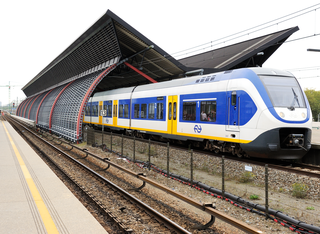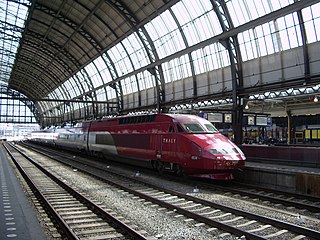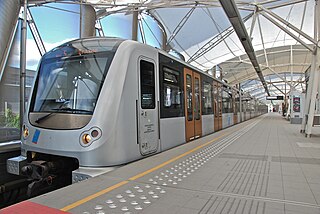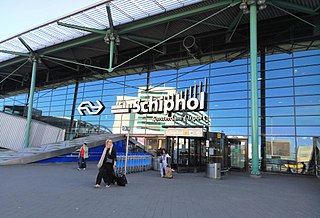Related Research Articles

Hoofddorp is the main town of the municipality of Haarlemmermeer, in the province of North Holland, the Netherlands. In 2021, the population was 77,885. The town was founded in 1853, immediately after the Haarlemmermeer had been drained.

The Amsterdam Metro is a rapid transit system serving Amsterdam, Netherlands, and extending to the surrounding municipalities of Diemen and Ouder-Amstel. Until 2019 it also served the municipality of Amstelveen but this route was closed and converted into a tram line. The network is owned by the City of Amsterdam and operated by municipal public transport company Gemeente Vervoerbedrijf (GVB) which also operates trams, free ferries and local buses.

The HSL-Zuid, is a 125 kilometre-long Dutch high-speed railway line running between the Amsterdam metropolitan area and the Belgian border, with a branch to Breda, North Brabant. Together with the Belgian HSL 4 it forms the Schiphol–Antwerp high-speed railway. Originally scheduled to be in service by 2007, the first public operations began on 7 September 2009, after a ceremony on 6 September.

The Zuidas is a rapidly developing business district in the city of Amsterdam in the Netherlands. The Zuidas is also known as the 'Financial Mile'. It lies between the rivers Amstel and Schinkel along the ringway A10. The greatest influences for the development of the Zuidas are La Défense in Paris and Canary Wharf in London. In size it can best be compared with the Noordruimte/Espace Nord in Brussels.

Amsterdam Zuid is a railway station situated in the borough of Amsterdam-Zuid in Amsterdam, Netherlands. For a number of years, it was named Amsterdam Zuid WTC, in reference to the neighbouring World Trade Center Amsterdam. During 2006, in conjunction with the rapid development of the area surrounding the station, the station was enlarged and the reference to the WTC was formally dropped from the name.

Amsterdam Sloterdijk is a major railway junction to the west of Amsterdam Centraal station. It is at a rail-rail crossing, with an additional chord (Hemboog). It is on the railway line from Amsterdam Centraal to Haarlem and the last station before the junction where the line Amsterdam Centraal-Zaandam diverges from it and on the crossing west branch of the Amsterdam–Schiphol railway line between Schiphol and Amsterdam Centraal.

Weesp is a railway station in Weesp, Netherlands. The station has two island platforms and it has a total of six tracks, from which two tracks are for passing trains. The first station in Weesp opened on June 10, 1874, when the Gooilijn from Amsterdam to Hilversum and Amersfoort was completed. The original station was demolished in 1967 and replaced by a new building. The new building partially went out of service in 1985 because of the new railway line from Weesp to Almere and beyond, called the Flevolijn. The out-of-service part was later converted to a bicycle parking and repair shop. The remaining station is little more than a tunnel passing under the tracks, and a small coffee counter. Train services are operated by Nederlandse Spoorwegen.

Rail transport in the Netherlands uses a dense railway network which connects nearly all major towns and cities. There are as many train stations as there are municipalities in the Netherlands. The network totals 3,223 route km (2,003 mi) on 6,830 kilometres (4,240 mi) of track; a line may run both ways, or two lines may run on major routes. Three-quarters of the lines have been electrified.

The Weesp–Leiden railway is a railway line in the Netherlands which runs between the cities of Weesp and Leiden; the line also passes through and serves Amsterdam Airport Schiphol.

Amsterdam RAI is a railway station situated in southern Amsterdam, Netherlands. It is located between the two directions of the A10 Amsterdam ring road. It is also a metro station at which GVB runs two lines. The station takes its name from the nearby RAI Amsterdam Convention Centre.

Amsterdam Lelylaan is a railway, metro, tram and bus station in west Amsterdam. It is served by trains of the Nederlandse Spoorwegen and metros of the GVB. The station opened on 1 June 1986. It is located on the Amsterdam-Schiphol railway, a few km south of Amsterdam Sloterdijk railway station. South of this station, trains turn west towards Schiphol railway station, while metros turn east towards Amsterdam Zuid railway station. The station is located in the Amsterdam borough of Slotervaart, on a long viaduct spanning three roads.

Hilversum is a railway station in Hilversum, Netherlands. It is located approximately 28 kilometres (17 mi) southeast of Amsterdam. It located on the Amsterdam Centraal station – Amersfoort station part of the Amsterdam–Zutphen railway, with a branch to Utrecht Centraal station. There are two other stations in Hilversum: Hilversum Media Park to the north, and Hilversum Sportpark to the south.

The Amsterdam–Zutphen railway is a railway line in the Netherlands running from Amsterdam, North Holland to Zutphen, Gelderland via the province of Utrecht. It passes through the cities of Hilversum, Amersfoort and Apeldoorn. It is also informally called the Oosterspoorweg, with the part between Amsterdam and Amersfoort sometimes being called the Gooilijn because of the region it runs through.

Rotterdam Centraal station is the main railway station of the city Rotterdam in South Holland, Netherlands. The station received an average of 112,000 passengers daily in 2019. The current station building, located at Station Square, was officially opened in March 2014.

High-speed rail service in the Netherlands started at 13 December 2009 with the dedicated HSL-Zuid line that connects the Randstad via Brussels to the European high-speed rail network. In later years improved traditional rail sections were added to the high-speed network. Proposals for more dedicated high-speed lines were deemed too costly; plans for the HSL-Oost to Germany were mothballed and instead of the Zuiderzeelijn the less ambitious Hanzelijn was built to enable future high-speed service between the northern provinces and the Randstad.

Brussels has an extensive network of both private or public transportation means. Public transportation includes Brussels buses, trams, and metro, as well as a set of railway lines and railway stations served by public trains. Air transport is available via one of the city's two airports, and boat transport is available via the Port of Brussels. Bicycle-sharing and car-sharing public systems are also available. The city is relatively car-dependent by northern European standards and is considered to be the most congested city in the world according to the INRIX traffic survey.

The Almelo–Salzbergen railway is an important Dutch and German 54 kilometre long railway line, that connects Almelo with Salzbergen, offering a rail link between the Netherlands and Germany.

The Amsterdam–Schiphol railway is an important 17 kilometre long railway line in the Netherlands that connects Amsterdam with Amsterdam Airport Schiphol, and allows trains to continue to Leiden, The Hague, and Rotterdam.

Schiphol Airport railway station is a major passenger railway station in Haarlemmermeer, Netherlands, beneath the terminal complex of Amsterdam Airport Schiphol, operated by the Nederlandse Spoorwegen. The station's six platforms are accessible via twelve escalators and three elevators located in the main concourse of the airport. The original station was opened in 1978, and the current station in 1995. It connects the airport to Amsterdam and other cities in the Netherlands, as well as to Belgium and France.